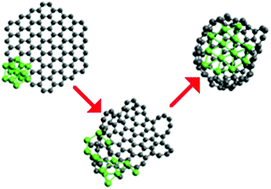Formation of nickel–carbon heterofullerenes under electron irradiation†
Abstract
A way to produce new metal–carbon nanoobjects by transformation of a graphene flake with an attached transition metal cluster under electron irradiation is proposed. The transformation process is investigated by molecular dynamics simulations by the example of a graphene flake with a nickel cluster. The parameters of the nickel–carbon potential (I. V. Lebedeva et al., J. Phys. Chem. C, 2012, 116, 6572) are modified to improve the description of the balance between the fullerene elastic energy and graphene edge energies in this process. The metal–carbon nanoobjects formed are found to range from heterofullerenes with a metal patch to particles consisting of closed fullerene and metal clusters linked by chemical bonds. The atomic-scale transformation mechanism is revealed by the local structure analysis. The average time of formation of nanoobjects and their lifetime under electron irradiation are estimated for the experimental conditions of high-resolution transmission electron microscopy (HRTEM). The sequence of images of nanostructure evolution with time during its observation by HRTEM is also modelled. Furthermore, the possibility of batch production of studied metal–carbon nanoobjects and solids based on these nanoobjects is discussed.

- This article is part of the themed collection: Organometallic and coordination chemistry of carbon nanomaterials

 Please wait while we load your content...
Please wait while we load your content...